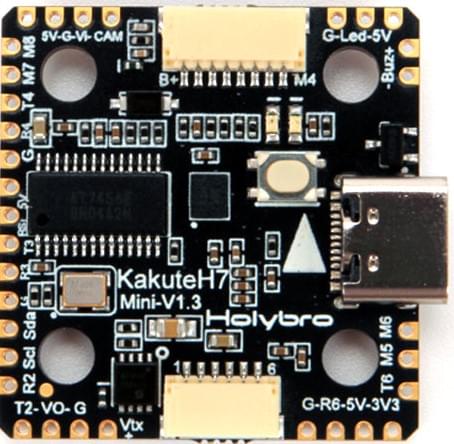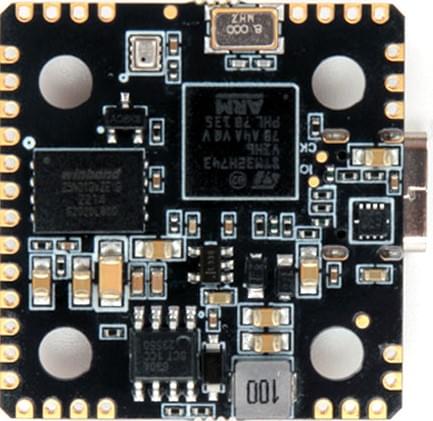# Holybro Kakute H7 mini
注意
PX4 does not manufacture this (or any) autopilot. Contact the manufacturer (opens new window) for hardware support or compliance issues.
The Holybro Kakute H7 mini (opens new window) flight controller is intended for lightweight frame builds (such as racers, etc.).
This flight controller is full of features including HD camera plug, dual plug-and-play 4in1 ESC ports, VTX ON/OFF Pit Switch (Battery Voltage), barometer, OSD, 6x UARTs, 128MB Flash for logging (not supported with PX4 yet), 5V BEC, and bigger soldering pad with easy layout and much more.
The Kakute H7 mini builds upon the best features of its predecessor, the Kakute F7, and the Kakute H7. The board also has an on-board barometer, LED & buzzer pad, and I2C pad (SDA & SCL) for external GPS/magnetometers.


注解
This flight controller is manufacturer supported.
注解
PX4 runs on the H7 mini v1.3 and later.
# Key Features
- MCU: STM32H743 32-bit processor running at 480 MHz
- IMU: BMI270
- Barometer: BMP280
- OSD: AT7456E
- 6x UARTs (1,2,3,4,6,7)
- VTX On/Off Pit Switch: Not used with PX4
- 9x PWM Outputs (8 Motor Outputs, 1 LED)
- 2x JST-SH1.0_8pin port (For Single or 4in1 ESCs, x8/Octocopter plug & play compatible)
- 1x JST-GH1.5_6pin port (For HD System like Caddx Vista & Air Unit)
- Battery input voltage: 2S-6S
- BEC 5V 2A Cont.
- Mounting: 20 x 20mm/Φ3.6mm hole with M3 & M2 Grommets
- Dimensions: 30x31x6mm
- Weight: 5.5g
# Where to Buy
The board can be bought from one of the following shops (for example):
# Connectors and Pins
| Pin | Function | PX4 default |
|---|---|---|
| B+ | Battery positive voltage (2S-6S) | |
| VTX+ | Battery positive voltage (2S-6S) | |
| SDA, SCL | I2C connection (for peripherals) | |
| 5V | 5V output (2A max) | |
| 3V3 | 3.3V output (0.25A max) | |
| VI | Video input from FPV camera | |
| VO | Video output to video transmitter | |
| CAM | To camera OSD control | |
| G or GND | Ground | |
| RSI | Analog RSSI (0-3.3V) input from receiver | |
| R1, T1 | UART1 RX and TX | TELEM1 |
| R3, T3 | UART3 RX and TX | NuttX debug console |
| R4, T4 | UART4 RX and TX | GPS1 |
| R6, T6 | UART6 RX and TX (R6 also located in the GH plug) | RC port |
| R7 | UART7 RX (RX is located in the plugs for use with 4-in-1 ESCs) | DShot telemetry |
| LED | WS2182 addressable LED signal wire (not tested) | |
| Z- | Piezo buzzer negative leg (Connect buzzer positive leg to 5V pad) | |
| M1 to M4 | Motor signal outputs (located in plug for use in 4-in-1 ESCs) | |
| M5 to M8 | Motor signal outputs (located in plug for use in 4-in-1 ESCs) | |
| Boot | Bootloader button |
# PX4 Bootloader Update
The board comes pre-installed with Betaflight (opens new window). Before the PX4 firmware can be installed, the PX4 bootloader must be flashed. Download the holybro_kakuteh7mini_bootloader.hex (opens new window) bootloader binary and read this page for flashing instructions.
# Building Firmware
To build PX4 for this target:
make holybro_kakuteh7mini_default
# Installing PX4 Firmware
注解
KakuteH7 is supported with PX4 master & PX4 v1.13 or newer. If you are loading the pre-built firmware via QGroundcontrol, you must use QGC Daily or QGC version newer than 4.1.7. Prior to that release you will need to manually build and install the firmware.
Firmware can be manually installed in any of the normal ways:
Build and upload the source:
make holybro_kakuteh7mini_default uploadLoad the firmware using QGroundControl. You can use either pre-built firmware or your own custom firmware.
注解
KakuteH7mini is supported with PX4 main and v1.14 or newer.
# PX4 Configuration
In addition to the basic configuration, the following parameters are important:
| Parameter | Setting |
|---|---|
| SYS_HAS_MAG | This should be disabled since the board does not have an internal mag. You can enable it if you attach an external mag. |
# Serial Port Mapping
| UART | Device | Port |
|---|---|---|
| USART1 | /dev/ttyS0 | TELEM1 |
| USART3 | /dev/ttyS2 | Debug Console |
| UART4 | /dev/ttyS3 | GPS1 |
| USART6 | /dev/ttyS4 | RC SBUS |
| UART7 | /dev/ttyS5 | ESC telemetry (DShot) |
# Debug Port
# System Console
UART3 RX and TX are configured for use as the System Console.
# SWD
The SWD interface (JTAG) pins are:
SWCLK: Test Point 2 (Pin 72 on the CPU)SWDIO: Test Point 3 (Pin 76 on CPU)GND: As marked on boardVDD_3V3: As marked on board